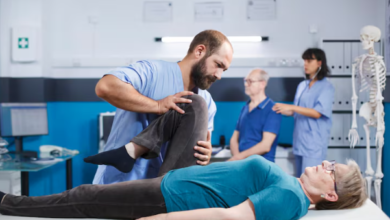5 Easy Ways: How to Stop Numbness in Legs and Feet

1. Change Your Position
Sometimes, that tingly, numb feeling in your legs and feet is just your body telling you it’s been in the same spot for too long. It’s like when your foot falls asleep after sitting cross-legged – pressure on a nerve. The simplest way to tackle this is to just shift your weight or get up and move around.
Think about how long you’ve been sitting or standing. If you’re at a desk, try standing up every 30 minutes. If you’re standing for a long time, shift your weight from one foot to the other. Even small adjustments can make a big difference in how to stop numbness in legs and feet.
Here are a few quick position changes to try:
- If sitting: Try uncrossing your legs or shifting to a different chair. If you’re on the couch, maybe lie down for a bit or prop your legs up.
- If standing: Gently bend your knees a little. This helps keep blood flowing better than standing rigidly. Try shifting your weight from your heels to your toes, or side to side.
- If lying down: If you’ve been on one side for a while, roll over. If you’re on your back, try bending your knees slightly.
It’s pretty common for numbness to pop up when a nerve gets squished. Changing how you’re positioned can often relieve that pressure and get things feeling normal again pretty fast. Don’t underestimate the power of a simple shift!
Sometimes, the numbness might be a sign of something else, but for those everyday
2. Gentle Stretching Exercises
When your legs and feet feel numb, it’s often because blood flow isn’t quite right, or nerves are getting squished. Gentle stretching can really help wake things up. It’s not about intense workouts, but more about moving your limbs in ways that encourage circulation and ease any tightness. Think of it as giving your legs a little nudge to get things flowing again.
Here are a few simple stretches you can try:
- Ankle Circles: Sit down and lift one foot slightly off the floor. Rotate your ankle in a full circle, about 10 times in one direction, then switch to the other. Do this for both feet. This helps get blood moving in those smaller joints.
- Calf Stretches: Stand facing a wall, about arm’s length away. Place your hands on the wall for support. Step one foot back, keeping that leg straight and your heel on the ground. Bend your front knee and lean forward slightly until you feel a stretch in the calf of your back leg. Hold for about 20-30 seconds, then switch legs. You can also do this with the back knee slightly bent to target a different part of the calf.
- Toe Curls: While sitting, place your feet flat on the floor. Try to scrunch your toes up, as if you’re trying to pick up a small object from the floor. Hold for a few seconds, then relax. Repeat this 10-15 times. This helps engage the muscles in your feet and lower legs.
Regularly incorporating these simple movements can make a noticeable difference in how your legs and feet feel.
It’s important to listen to your body. If any stretch causes pain, stop immediately. The goal is to gently encourage blood flow and nerve function, not to push yourself into discomfort. Consistency is key here; even a few minutes each day can be beneficial.
3. Take a Brisk Walk
When your legs and feet start feeling that familiar tingle or go completely numb, it’s a sign that something needs to change. Often, it’s just a matter of getting your blood flowing again. A brisk walk is one of the simplest and most effective ways to do just that. It doesn’t have to be a marathon; even a short, brisk walk around the block can make a big difference.
Moving your legs helps improve circulation, which can quickly alleviate that numb or pins-and-needles feeling. Think of it like jump-starting a sluggish engine. When you’re sitting or standing still for too long, you can accidentally put pressure on nerves and blood vessels, cutting off that vital flow. Walking gets everything moving again.
Here’s why it helps:
- Boosts Circulation: The rhythmic motion of walking gets your blood pumping, delivering oxygen and nutrients to your extremities.
- Relieves Nerve Compression: Gentle movement can help release pressure on nerves that might be getting squished.
- Improves Overall Health: Regular walks contribute to better cardiovascular health, which is good for your whole body, including your legs and feet.
If you’ve been sitting for a while, especially in a position that might be cutting off circulation, getting up and moving is key. Even a few minutes of walking can help prevent that uncomfortable numbness from setting in or getting worse. Just be sure to keep a slight bend in your knees when you’re standing or walking to avoid restricting blood flow.
Try to incorporate short walks throughout your day, especially if you have a job or lifestyle that involves a lot of sitting. It’s a small habit that can have a significant impact on keeping your legs and feet feeling normal and comfortable.
4. Massage Affected Areas
When your legs or feet feel numb, a gentle massage can really help wake things up. It’s all about getting the blood flowing better and encouraging those nerves to get back in touch. Think of it like gently coaxing your limbs back to life.
Start by softly pressing and stretching the muscles in your feet and legs. This gets them ready for a bit more attention. Then, you can use your thumbs or knuckles to work on the soles of your feet and along your calves. Use long, smooth strokes. The key is to be firm but not painful. If you feel any discomfort, ease up. You want to feel a good pressure, but never pain.
Here are a few things to keep in mind:
- Always listen to your body. If something hurts, stop.
- Avoid using heat on numb areas, as you might not be able to tell if it’s too hot and could burn yourself.
- If the numbness is persistent or you’re unsure about the cause, it’s a good idea to chat with your doctor or even neurology doctors to figure out what’s going on.
Sometimes, numbness can be a sign of something more serious, so it’s always best to get it checked out if it doesn’t go away or if it comes with other weird symptoms. Don’t just ignore it!
After massaging, finish with lighter strokes that gradually decrease in pressure. This helps your legs and feet relax back to normal.
5. Take a Salt Bath
Sometimes, a simple warm bath can do wonders, and adding Epsom salts can make it even better for those achy, numb legs and feet. The magnesium in Epsom salts is thought to help boost circulation, which is exactly what you need when your limbs feel like they’ve gone to sleep. It’s a pretty straightforward thing to do, really. Just fill up your tub with warm water – not too hot, especially if you have numbness, because you might not feel if it’s scalding – and pour in a cup or two of Epsom salts. Give it a good stir to make sure it all dissolves. Then, just soak for about 15 to 20 minutes. It’s a nice, relaxing way to give your legs and feet some attention.
Here’s a quick rundown:
- Gather your supplies: You’ll need Epsom salts and a bathtub.
- Fill the tub: Use warm water. Be cautious with the temperature.
- Add the salts: About 1-2 cups should do it.
- Soak away: Relax for 15-20 minutes.
This kind of soak can really help ease that tingly, heavy feeling. It’s a gentle way to encourage blood flow back into your extremities and just generally feel more comfortable. Plus, who doesn’t love a good bath?
It’s a low-effort way to potentially get some relief and feel a bit more connected to your feet and legs again. Just make sure you dry off really well afterward, especially between your toes, to prevent any skin issues.
Frequently Asked Questions
What usually causes that ‘pins and needles’ feeling in my legs and feet?
Most of the time, that tingly or numb feeling happens because you’ve been sitting or standing in the same position for too long. This can put pressure on your nerves, kind of like when your leg ‘falls asleep.’ Luckily, this usually goes away on its own once you move around.
When should I worry about leg or foot numbness?
While temporary numbness is common, you should talk to a doctor if it happens often, lasts a long time, or if it’s really severe. It could be a sign of a bigger health issue like diabetes, circulation problems, or nerve damage.
Can exercise help with leg numbness?
Absolutely! Moving your legs helps get your blood flowing better. Simple things like going for a brisk walk or doing some gentle leg stretches can make a big difference in bringing back feeling and preventing numbness.
How does taking a salt bath help with numb feet?
Soaking your feet in an Epsom salt bath can be quite soothing. The magnesium in Epsom salts is thought to help improve blood flow, which can ease that numb or tingly sensation. Just make sure the water isn’t too hot!
Is massage a good way to relieve leg numbness?
Yes, massaging the sore or numb areas can really help. It works by encouraging blood to flow better and can wake up your nerves. Gently massaging your feet and legs can help ease the discomfort and bring back feeling.
What if my numbness is due to a condition like fibromyalgia?
For conditions like fibromyalgia, numbness can be a tricky symptom. While home remedies like stretching and massage can offer some relief, it’s important to work with your doctor. They can help you manage the condition with things like physical therapy, stress management, and sometimes medication.





